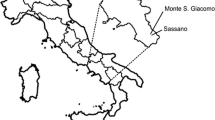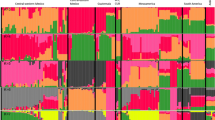Abstract
Chloroplast DNA polymorphisms were studied by PCR sequencing and PCR-restriction fragment length polymorphism in 165 accessions of domesticated landraces of common bean from Latin America and the USA, 23 accessions of weedy beans, and 134 accessions of wild beans covering the entire geographic range of wild Phaseolus vulgaris. Fourteen chloroplast haplotypes were identified in wild beans, only five of which occur also in domesticated beans. The chloroplast data agree with those obtained from analyses based on morphology and isozymes and with other DNA polymorphisms in supporting independent domestications of common bean in Mesoamerica and the Andean region and in demonstrating a founder effect associated with domestication in each region. Andean landraces have been classified into three different racial groups, but all share the same chloroplast haplotype. This suggests that common bean was domesticated once only in South America and that the races diverged post-domestication. The haplotype found in Andean domesticated beans is confined to the southern part of the range of wild beans, so Andean beans were probably domesticated somewhere within this area. Mesoamerican landraces have been classified into four racial groups. Our limited samples of Races Jalisco and Guatemala differ from the more widespread and commercially important Races Mesoamerica and Durango in types and/or frequencies of haplotypes. All four Mesoamerican races share their haplotypes with local wild beans in parts of their ranges. Independent domestications of at least some of the races in Mesoamerica and/or conversion of some locally adapted wild beans to cultigens by hybridization with introduced domesticated beans, followed by introgression of the “domestication syndrome” seem the most plausible explanations of the chloroplast and other molecular data.




Similar content being viewed by others
References
Anderson GJ, Jansen RK, Kim Y (1996) The origin and relationships of the pepino, Solanum muricatum (Solanaceae): DNA restriction fragment evidence. Econ Bot 50:369–380
Andrade-Aguilar JA, Hernandez-Xolocotzi E (1991) Diversity of common beans (Phaseolus vulgaris, Fabaceae) and conditions of production in Aguascalientes, Mexico. Econ Bot 45:339–344
Andres T (1990) Biosystematics, theories on the origin, and breeding potential of Cucurbita ficifolia. In: Bates DM, Robinson RW, Jeffrey C (eds) Biology and utilization of the Cucurbitaceae. Cornell University, New York, pp 102–119
Asmussen CB, Liston A (1998) Chloroplast DNA characters, phylogeny and classification of Lathyrus (Fabaceae). Am J Bot 85:387–401
Becerra Velásquez VL, Gepts P (1994) RFLP diversity of common bean (Phaseolus vulgaris) in its centers of origin. Genome 37:256–263
Beebe S, Toro Ch O, González AV, Chacon MI, Debouck DG (1997) Wild-weed–crop complexes of common bean (Phaseolus vulgaris L., Fabaceae) in the Andes of Peru and Colombia, and their implications for conservation and breeding. Genet Res Crop Evol 44:73–91
Beebe S, Skroch PW, Tohme J, Duque MC, Pedraza F, Nienhuis J (2000) Structure of genetic diversity among common bean landraces of Middle American origin based on correspondence analysis of RAPD. Crop Sci 40:264–273
Beebe S, Rengifo J, Gaitan E, Duque MC, Tohme J (2001) Diversity and origin of Andean landraces of common bean. Crop Sci 41:854–862
Brubaker CL, Wendel JF (1994) Reevaluating the origin of domesticated cotton (Gossypium hirsutum Malvaceae) using nuclear restriction-fragment-length- polymorphisms (RFLPs). Am J Bot 81:1309–1326
Buckler ES IV, Holtsford TP (1996) Zea systematics: ribosomal ITS evidence. Mol Biol Evol 13:612–622
Cattan-Toupance I, Michalakis Y, Neema C (1998) Genetic structure of wild bean populations in their South-Andean center of origin. Theor Appl Genet 96:844–851
Chacón M (2001) Chloroplast DNA polymorphisms and the evolution and domestication of the common bean (Phaseolus vulgaris L.) Agricultural botany. The University of Reading, Reading, UK
Chacón MI, González AV, Gutiérrez JP, Beebe S, Debouck DG (1996) Increased evidence for common bean (Phaseolus vulgaris L.) domestication in Colombia. Annu Rep Bean Improv Coop 39:201–202
Clegg MT, Brown AHD, Whitfeld PR (1984) Chloroplast DNA diversity in wild and cultivated barley: implications for genetic conservation. Genet Res 43:339–343
Corriveau JL, Coleman AW (1988) Rapid screening method to detect potential biparental inheritance of plastid DNA for over 200 angiosperm species. Am J Bot 75:1443–1458
Debouck DG, Toro O, Paredes OM, Johnson WC, Gepts P (1993) Genetic diversity and ecological distribution of Phaseolus vulgaris (Fabaceae) in northwestern South America. Econ Bot 47:408–423
Diamond J (1997) Guns, germs and steel: the fates of humans societies. NW Norton, New York
DNAStar (1994) lasergene. Biocomputing software for the Macintosh. DNASTAR, Madison, Wis.
Doebley J (1992) Molecular systematics and crop evolution. In: Soltis PS, Soltis DE, Doyle JJ (eds) Molecular systematics of plants. Chapman and Hall, New York, pp 202–222
Doyle JJ, Doyle JL (1987) A rapid DNA isolation procedure for small quantities of fresh leaf tissue. Phytochem Bull 19:11–15
Excoffier L, Smousse P (1994) Using allele frequencies and geographic subdivision to reconstruct gene genealogies within a species: molecular variance parsimony. Genetics 136:343–359
Fofana B, Harvengt L, Baudoin JP, du Jardin P (1997) New primers for the polymerase chain amplification of cpDNA intergenic spacers in Phaseolus phylogeny. Belg J Bot 129:118–122
Gepts P (1988a) Genetic resources of Phaseolus beans: current plant science and biotechnology in agriculture. In: Gepts P (ed) Genetic Resources of Phaseolus beans. Kluwer, Dordrecht, p 619
Gepts P (1988b) Phaseolin as an evolutionary marker. In: Gepts P (ed) Genetic Resources of Phaseolus Beans. Kluwer, Dordrecht, pp 215–241
Gepts P, Bliss FA (1986) Phaseolin variability among wild and cultivated common bean (Phaseolus vulgaris) from Colombia. Econ Bot 40:469–478
Gepts P, Bliss FA (1988) Dissemination pathways of common bean (Phaseolus vulgaris, Fabaceae) deduced from phaseolin electrophoretic variability. II. Europe and Africa. Econ Bot 42:86–104
Gepts P, Debouck D (1991) Origin, domestication, and evolution of the common bean (Phaseolus vulgaris, L.). In: van Schoonhoven A, Voysest O (eds) Common beans: research for crop improvement. Commonwealth Agricultural Bureaux International, Wallingford, pp 7–53
Gepts P, Osborn TC, Rashka K, Bliss FA (1986) Phaseolin-protein variability in wild forms and landraces of the common bean (Phaseolus vulgaris): evidence for multiple centers of domestication. Econ Bot 40:451–468
Gepts P, Kmiecik K, Pereira P, Bliss FA (1988) Dissemination pathways of common bean (Phaseolus vulgaris, Fabaceae) deduced from phaseolin electrophoretic variability. I. The Americas. Econ Bot 42:73–85
Gutiérrez Salgado A, Gepts P, Debouck DG (1995) Evidence for two gene pools of the lima bean, Phaseolus lunatus L., in the Americas. Genet Res Crop Evol 42:15–28
Harlan JR (1992) Crops and man. American Society of Agronomy/Crop Science Society of America, Madison
Heun M, Schäfer-Pregl R, Klawan D, Castagna R, Accerbi M, Borghi B, Salamini F (1997) Site of einkorn wheat domestication identified by DNA fingerprinting. Science 278:1312–1314
Hilton H, Gaut BS (1998) Speciation and domestication in maize and its wild relatives: evidence from the Globulin-1 gene. Genetics 150:863–872
Hosaka K, Hanneman RE Jr (1988) Origin of chloroplast DNA diversity in the Andean potatoes. Theor Appl Genet 76:333–340
Ibarra-Perez FJ, Ehdaie B, Waines JG (1997) Estimation of outcrossing rates in common bean. Crop Sci 37:60–65
Jones PG, Beebe S, Tohme J (1997) The use of geographical information systems in biodiversity exploration and conservation. Biodivers Conserv 6:947–958
Jordan WC, Courtney MW, Neigel JE (1996) Low levels of intraspecific genetic variation at a rapidly evolving chloroplast DNA locus in North America Duckweeds (Lemnaceae). Am J Bot 83:430–439
Kaplan L (1981) What is the origin of the common bean. Econ Bot 35:240–254
Kaplan L, Lynch TF (1999) Phaseolus (Fabaceae) in archaeology: AMS radiocarbon dates and their significance for pre-Columbian agriculture. Econ Bot 53:261–272
Khairallah MM, Sears BB, Adams MW (1992) Mitochondrial restriction fragment length polymorphisms in wild Phaseolus vulgaris L.: insights on the domestication of the common bean. Theor Appl Genet 84:915–922
Koinange EMK, Singh SP, Gepts P (1996) Genetic control of the domestication syndrome in common bean. Crop Sci 36:1037–1045
Manen JF, Natali A, Ehrendorfer F (1994) Phylogeny of Rubiaceae–Rubieae inferred from the sequence of a cpDNA intergene region. Plant Syst Evol 190:195–211
Nei M (1987) Molecular evolutionary genetics. Columbia University Press, New York
Palmer JD, Shields CR, Cohen DB, Orton TJ (1983) Chloroplast DNA evolution and the origin of amphidiploid Brassica species. Theor Appl Genet 65:181–189
Papa R, Gepts P (2003) Asymmetry of gene flow and differential geographical structure of molecular diversity in wild and domesticated common bean (Phaseolus vulgaris L.) from Mesoamerica. Theor Appl Genet 106:239–250
Pickersgill B (1989) Cytological and genetical evidence on the domestication and diffusion of crops within the Americas. In: Harris DR, Hillman GC (eds) Foraging and farming: the evolution of plant exploitation. Unwin Hyman, London, pp 426–439
Sanjur OI, Piperno DR, Andres TC, Wessel-Beaver L (2002) Phylogenetic relationships among domesticated and wild species of Cucurbita (Cucurbitaceae) inferred from a mitochondrial gene: implications for crop plant evolution and areas of origin. Proc Natl Acad Sci USA 99:535–540
Schmit V, du Jardin P, Baudoin JP, Debouck DG (1993) Use of chloroplast DNA polymorphisms for the phylogenetic study of seven Phaseolus taxa including P. vulgaris and P. coccineus. Theor Appl Genet 87:506–516
Schneider S, Roessli D, Excoffier L (2000) arlequin ver. 2000: a software for population genetics data analysis. Genetics and Biometry Laboratory, University of Geneva, Geneva, Switzerland
Singh SP, Gepts P, Debouck DG (1991) Races of common bean (Phaseolus vulgaris, Fabaceae). Econ Bot 45:379–396
Small RL, Ryburn JA, Cronn RC, Seelanan T, Wendel JF (1998) The tortoise and the hare: choosing between noncoding plastome and nuclear Adh sequences for phylogeny reconstruction in a recently diverged plant group. Am J Bot 85:1301–1315
Smith B (1997) The initial domestication of Cucurbita pepo in the Americas 10,000 years ago. Science 276:932–934
Sonnante G, Stockton T, Nodari RO, Becerra Velásquez VL, Gepts P (1994) Evolution of genetic diversity during the domestication of common bean (Phaseolus vulgaris L.). Theor Appl Genet 89:629–635
Taberlet P, Gielly L, Pautou G, Bouvet J (1991) Universal primers for amplification of three non-coding regions of chloroplast DNA. Plant Mol Biol 17:1105–1109
Tohme J, Orlando González D, Beebe S, Duque MC (1996) AFLP analysis of gene pools of a wild bean core collection. Crop Sci 36:1375–1384
Voysest O, Valencia MC, Amezquita MC (1994) Genetic diversity among Latin-American Andean and Mesoamerican common bean cultivars. Crop Sci 34:1100–1110
Wendel JF, Brubaker CL, Percival AE (1992) Genetic diversity in Gossypium-Hirsutum and the origin of upland cotton. Am J Bot 79:1291–1310
Zohary D (1999) Monophyletic vs. polyphyletic origin of the crops on which agriculture was founded in the Near East. Genet Res Crop Evol 46:133–142
Acknowledgements
The work reported here formed part of the PhD thesis of the senior author and was supported by a COLCIENCIAS-BID studentship from the Colombian Government and by an Overseas Research Studentship from the Government of the United Kingdom. We thank the following from CIAT: the Genetic Resources Unit for providing the plant material used in this study; Orlando Toro for his assistance in selecting the plant material; Steve Beebe for providing data on race classification; César Ocampo for information on his phaseolin analyses. Thanks are also due to George Gibbings and Moy Robson from the School of Plant Sciences, the University of Reading, for their assistance with molecular techniques. We are also grateful to two anonymous referees for their constructive criticisms of the original manuscript.
Author information
Authors and Affiliations
Corresponding author
Additional information
Communicated by A. Charcosset
Rights and permissions
About this article
Cite this article
Chacón S, M.I., Pickersgill, B. & Debouck, D.G. Domestication patterns in common bean (Phaseolus vulgaris L.) and the origin of the Mesoamerican and Andean cultivated races. Theor Appl Genet 110, 432–444 (2005). https://doi.org/10.1007/s00122-004-1842-2
Received:
Accepted:
Published:
Issue Date:
DOI: https://doi.org/10.1007/s00122-004-1842-2




